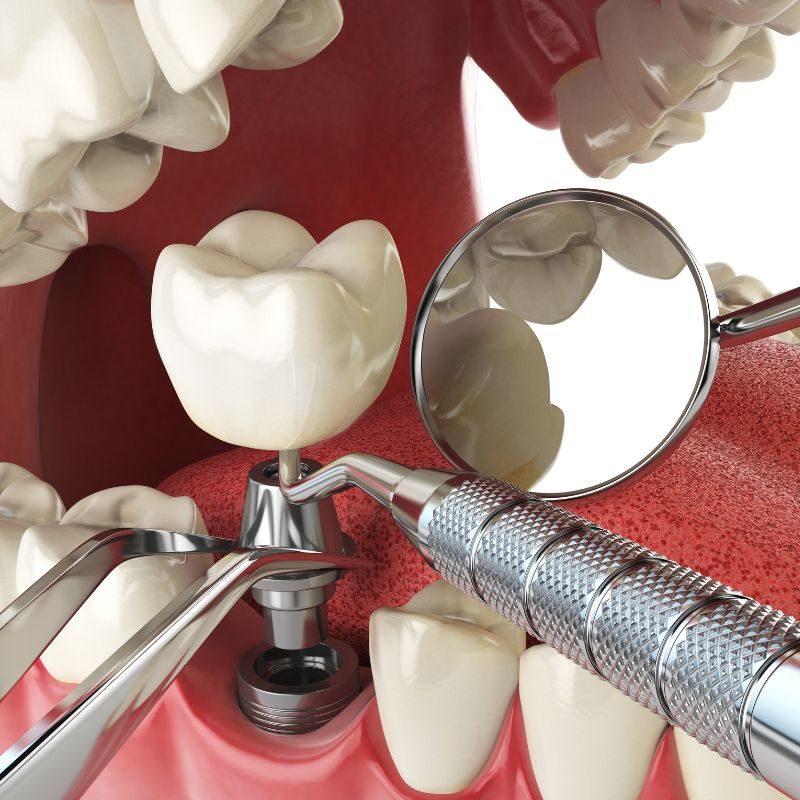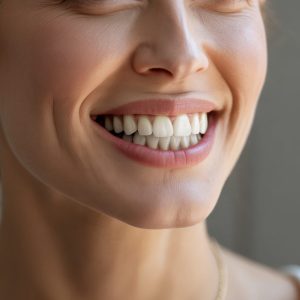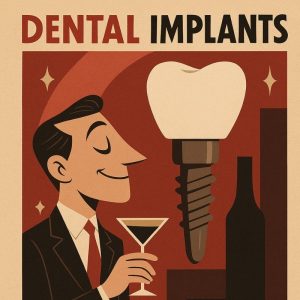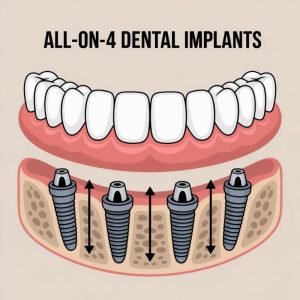Have you ever been told by your dentist that you need a crown? Or perhaps you have a tooth that is severely damaged, discolored, or weakened, and you’re exploring your options. You’ve likely heard the term “dental crown,” but you may still be wondering, what is a dental crown exactly?
Think of a dental crown as a custom-made “cap” that is placed over a tooth. Its purpose is to completely cover the visible portion of the tooth above the gum line, restoring its shape, size, strength, and improving its overall appearance. Once cemented into place, a crown encases the entire tooth, becoming its new outer surface. This comprehensive guide will walk you through everything you need to know about this common and highly effective dental restoration.
When is a Dental Crown Necessary?
A dentist might recommend a dental crown for a variety of reasons, both restorative and cosmetic. They are one of the most versatile tools in a dentist’s arsenal for preserving a tooth’s function and enhancing a smile’s aesthetics. Here are some of the most common situations where a crown is the best solution:
- To Protect a Weak Tooth: If a tooth has been weakened by extensive decay, a large filling, or a crack, it is at high risk of fracturing. A crown holds the tooth together, providing the strength and support it needs to withstand the forces of chewing.
- To Restore a Broken or Severely Worn Tooth: Teeth can break due to trauma or become worn down from habits like teeth grinding (bruxism). A crown can be used to rebuild the tooth’s structure, restoring its original shape and function.
- To Cover and Support a Tooth with a Large Filling: When a cavity is so large that there isn’t much natural tooth structure left, a filling alone may not be sufficient. The remaining tooth is often too weak to support the filling and can easily fracture. A crown provides the necessary reinforcement.
- To Hold a Dental Bridge in Place: A dental bridge is used to replace one or more missing teeth. It consists of one or more artificial teeth (pontics) that are held in place by crowns placed on the natural teeth on either side of the gap.
- To Cover a Dental Implant: A dental implant is a titanium post that is surgically placed into the jawbone to act as a replacement tooth root. A dental crown is then attached to the top of the implant to create a complete, functional, and natural-looking replacement tooth. At Dental Theory, we offer implant-supported crowns as a gold standard for tooth replacement.
- To Cover a Misshapen or Severely Discolored Tooth: For teeth that are cosmetically unappealing due to their shape, size, or deep intrinsic staining that doesn’t respond to whitening, a crown can provide a complete smile makeover.
- To Cover a Tooth That Has Had a Root Canal: A root canal procedure is performed to save a tooth that has become infected or inflamed on the inside. While the procedure saves the tooth, it can often leave it more brittle and prone to fracture. A crown is almost always placed over a tooth after a root canal to protect it from future damage.
What are Dental Crowns Made Of?
Dental crowns can be made from several different materials, and the best choice for you will depend on factors like the location of the tooth, the amount of force it will be under, your aesthetic preferences, and your budget.
All-Ceramic or All-Porcelain
These crowns provide the best natural color match and are an excellent choice for front teeth. They are biocompatible, meaning they are not likely to cause allergic reactions. With modern advancements, ceramic crowns are now stronger and more durable than ever, making them a suitable option for molars as well.
Porcelain-Fused-to-Metal (PFM)
PFM crowns have a metal substructure with a layer of porcelain fused to the outside. This construction combines the strength of metal with the aesthetic appeal of porcelain. They are very durable and have been a reliable choice for many years. One potential downside is that the metal underlying the porcelain can sometimes show through as a dark line at the gum line, especially if the gums recede.
Zirconia
Zirconia is a type of ceramic that is incredibly strong and durable, making it an excellent choice for back teeth that endure a lot of chewing pressure. It is also highly resistant to chipping and cracking. Zirconia crowns can be milled and shaded to match the color of your natural teeth, offering a good blend of strength and aesthetics.
Gold and Metal Alloys
Crowns made from gold alloys or other metal alloys (like palladium or nickel-chromium) are extremely strong and durable. They rarely chip or break, and they require less of the natural tooth to be removed before placement. The main drawback is their metallic color, which is why they are most often used for out-of-sight molars.
The Same-Day Dental Crown Procedure: A Modern, One-Visit Solution
Traditionally, getting a dental crown was a multi-week process that required at least two separate appointments. However, thanks to incredible advancements in dental technology, practices like Dental Theory can now design, create, and place your permanent crown in a single visit! This technology eliminates the need for messy impressions and uncomfortable temporary crowns.
So, what is a dental crown procedure like when it’s completed on the same day? Here’s a step-by-step guide to the modern, streamlined process:
Your One and Only Visit: From Preparation to Placement
-
Digital Scanning (No More Goop!): After examining the tooth and administering a local anesthetic to ensure your comfort, the first step is to take a digital impression. Instead of using trays filled with putty-like impression material, your dentist uses a small, handheld intraoral scanner. This camera quickly captures thousands of images of your tooth, creating a precise, 3D digital model on a computer screen. This model is incredibly accurate and far more comfortable for the patient.
-
Custom Crown Design: With the 3D model of your tooth on the screen, your dentist uses specialized CAD (Computer-Aided Design) software to design your custom crown right then and there. They will meticulously shape the virtual crown to ensure it fits perfectly with your bite and matches the anatomy of your other teeth. You can even watch as your new crown is designed. The color is also selected to seamlessly blend with your natural smile.
-
In-Office Milling: Once the design is finalized, the digital file is sent to an in-office milling machine. This is where the magic happens. A solid block of high-quality, tooth-colored ceramic (often zirconia or another durable material) is placed into the machine. The milling unit then acts like a 3D printer in reverse, precisely carving your custom crown from the block based on the digital design. This process is surprisingly fast, typically taking anywhere from 15 to 30 minutes.
-
Final Touches and Firing: After the crown is milled, your dentist will check it for a perfect fit and make any minor adjustments. To achieve a natural-looking finish and add strength, the crown may be polished, stained, and glazed. It is then placed in a special oven or furnace for a short time to cure and harden the porcelain, a process called firing. This ensures maximum durability and gives the crown a beautiful, lifelike translucency.
-
Bonding Your Permanent Crown: The final step is to permanently bond the crown to your prepared tooth. Your dentist will clean the tooth, apply a strong dental adhesive, and carefully place your new, custom-milled crown. After a final check of your bite, you are ready to go. You leave the office with a fully restored, permanent tooth—no follow-up appointment needed.
The ability to complete the entire process in a single visit is a game-changer in modern dentistry, saving you time and providing immediate results. If you have more questions about what is a dental crown or want to experience the convenience of a same-day crown, the best step is to schedule a consultation. Dr. K. can evaluate your specific situation and determine if this advanced restoration is the right solution to restore your smile’s health, function, and beauty.
Caring for Your Dental Crown
A dental crown can last anywhere from 5 to 15 years, or even longer, with proper care. While the crown itself cannot decay, the underlying tooth is still vulnerable to cavities at the gum line. To extend the life of your crown, it’s essential to practice good oral hygiene:
- Brush twice a day and floss daily: Pay special attention to the area where the gum meets the crown to remove plaque.
- Avoid hard and sticky foods: Chewing on hard things like ice or hard candy can damage your crown. Sticky foods can potentially pull the crown off.
- Attend regular dental check-ups: Professional cleanings and exams will help ensure your crown and the underlying tooth remain healthy.
If you have more questions about what is a dental crown or believe you might need one, the best step is to schedule a consultation. An experienced dentist can evaluate your specific situation and determine if a dental crown is the right solution to restore your smile’s health, function, and beauty.







